Ancona
Ducks: A Critically Endangered Bird
Great
for the self-sufficient homestead. Fun to raise. Good pets.
"Your ducks are so beautiful- the ones we hatched are
vibrant!" -Kat, Gainesville, Georgia
Ancona
Duck - Hardy, All Purpose Domestic Waterfowl
 Ancona ducks make good pets because they do not migrate, do not even fly,
and like staying close to home. They are calm, and if handled when young
are friendly and affectionate.
Ancona ducks make good pets because they do not migrate, do not even fly,
and like staying close to home. They are calm, and if handled when young
are friendly and affectionate.
"I hatched Ancona duckies in my senior year in
high school and they all imprinted me! They followed me everywhere just
like the geese in the movie Fly Away Home. (Without the flying part since
mine didn't fly.) It was an awesome experience I'm hoping to have happen
again :)" -Ashley, Newberg, Oregon
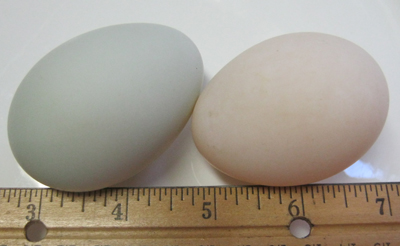 The hens are excellent layers usually laying 210-280 cream (off-white),
green or blue eggs each year. Most of my Ancona ducks lay cream eggs. A
few lay green eggs. Their eggs are larger than chicken eggs.
The hens are excellent layers usually laying 210-280 cream (off-white),
green or blue eggs each year. Most of my Ancona ducks lay cream eggs. A
few lay green eggs. Their eggs are larger than chicken eggs.
If we raise a duck or chicken as a pet, we do not eat them. They live a
full life until old age comes. But we do raise some for eating and don't
become too friendly with them. They have a very good life, enjoying the
pasture and the natural farm life.
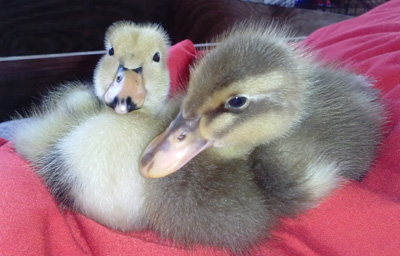 Ancona
ducks grow fairly quickly producing high quality meat that is more flavorful
and less fatty than Pekin ducks (Long Island duck). We had one male duck
for Christmas dinner and were very happy with it. They are a great dual
purpose (meat and egg) bird. Ancona
ducks grow fairly quickly producing high quality meat that is more flavorful
and less fatty than Pekin ducks (Long Island duck). We had one male duck
for Christmas dinner and were very happy with it. They are a great dual
purpose (meat and egg) bird.
Ancona Ducks are robust and capable of enduring hard conditions. They adapt
well to various environments. (Of course, the better their environment,
the healthier they will be.) They are good foragers even being able to eat
banana slugs (a large land slug) and other unwanted garden pests. They like
greens and insects.
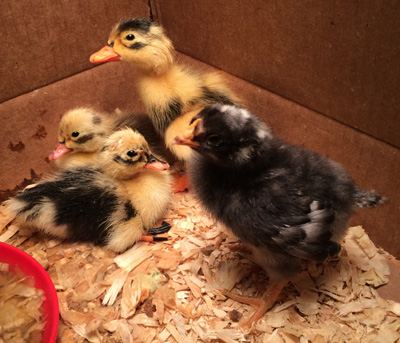 They are large birds so most winged predators leave them alone. It is good
to provide some protection against predators such as dogs. An outer perimeter
fence is a good idea.
They are large birds so most winged predators leave them alone. It is good
to provide some protection against predators such as dogs. An outer perimeter
fence is a good idea.
We let our chickens and ducks share the same coop though some recommend
keeping them apart. They get along fine. They lay their eggs in the same
nest boxes as the chickens. During the day the ducks forage together as
a group.
The top photo is 2 drakes and 2 hens. The drakes are bigger. Drakes also
have a curl at the end of their tail. Then 2 ducklings. One is a Tricolor.
(Photo from Rachele, Fort Myers, Florida.) Then a photo of 3 Ancona ducklings
and 1 Dominique chick.
"We ordered five of your Ancona duck eggs to hatch.
We live on a farm, and have a pond and a two-year-old farmboy but no ducks...must
remedy this situation! Thanks so much for providing duck eggs for our incubating
experience in a small quantity and for a great price." -Abi, Fulks Run,
Virginia
Ancona Breed
Characteristics
 They
are descended from Indian Runner ducks and Belgian Huttegem ducks. This is the
same foundation stock as Magpie ducks and Dutch Hookbills. They were developed
in England during the early 1900s but were not shipped to the United States
until 1984. They
are descended from Indian Runner ducks and Belgian Huttegem ducks. This is the
same foundation stock as Magpie ducks and Dutch Hookbills. They were developed
in England during the early 1900s but were not shipped to the United States
until 1984.
Ancona ducks weigh about 6 to 6.5 pounds as adults. Males weigh more than females.
It is stockier than the Magpie duck. Ducks live to be 10 years or older.
Adult
plumage is white with pinto (dappled, speckled) markings (each animal has a different
pattern). Colors include black and white, blue and white, chocolate and white,
silver and white, lavender and white, and tri-colored. The most common is black
and white. Any pattern combination is acceptable as long as there are broken colors
on the duck.
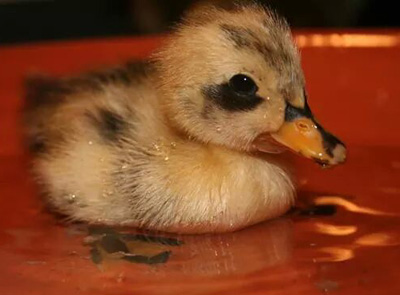 Some
are all white though this is not the breed standard. Ducks with an all white
bib are not the breed standard either. The Ancona is not yet recognized by the
American Poultry Association. Unique patterns are preferred. Birds with high
egg production are also preferred. Some
are all white though this is not the breed standard. Ducks with an all white
bib are not the breed standard either. The Ancona is not yet recognized by the
American Poultry Association. Unique patterns are preferred. Birds with high
egg production are also preferred.
Chocolate color is sex-linked (carried by the male only) and recessive. If a
chocolate drake (male) mates with a black hen, all female offspring are chocolate
and all male offspring are black. A black drake mated to a chocolate hen produce
only black offspring.
The neck is usually solid white. The bill is yellow with dark green or black
spotting. The legs and feet are orange with black or brown markings (spotting)
that increase with age.
 Female ducks start to lay eggs from 17 to 34 weeks (4 1/4 to 8 1/2 months) old. They lay for 5 to 8 years with the most productivity in the first 3 years. Eggs get bigger as the birds get older. They usually lay their eggs between 4 and 7 am. The eggs incubate
for 28 days.
Female ducks start to lay eggs from 17 to 34 weeks (4 1/4 to 8 1/2 months) old. They lay for 5 to 8 years with the most productivity in the first 3 years. Eggs get bigger as the birds get older. They usually lay their eggs between 4 and 7 am. The eggs incubate
for 28 days.
"Just candled, and it looks like I have 6 Ancona duck eggs that are fertile and growing! Clear tiny little heartbeats and veins. I am so excited!" -Jill, Chapel Hill, North Carolina
Ducklings are yellow with spots or speckles. Yellow markings turn
white when they become adults. When brooding ducklings, they like a shallow plate
of water to bathe in. But it should not be too deep because ducklings can drown.
Raising them is the same as chickens except they need more B vitamins than chicks.
Get a good book on ducks such as "Storey's Guide to Raising Ducks". They are a
lot of fun.
Raising Rare
Duck Breeds
 Ancona
Ducks are considered rare (critical status) by the American
Livestock Breeds Conservancy (ALBC). In 2000 ALBC's census of
domestic waterfowl in North America found only 128 breeding Ancona ducks. Ancona
Ducks are considered rare (critical status) by the American
Livestock Breeds Conservancy (ALBC). In 2000 ALBC's census of
domestic waterfowl in North America found only 128 breeding Ancona ducks.
Ancona ducks are a lively bird to raise. Some people spell it Anacona or Anaconda.
They are fun to watch as the group moves around the pasture. If they are disturbed
by what is going on, they make noise to let everyone know.
They love having a pond but if you don't have one you can use a kiddie pool
or other container that has a ramp in and out of the pool. In the winter empty
the pool when you close up the coop for the night. Then refill in the morning.
The water won't freeze here in Western North Carolina except on really cold
days.
The photo to the left is 2 hens. One is black and white. The brown one is a
Tricolor with gray and wild mallard patterns. Notice the speckled beak.
"Our 15-year-old granddaughter is very involved
in FFA (Future Farmers of America), and this is a school/FFA project we
are assisting her with. The duck pond is nearly complete, then the duck
house, and the project will culminate with the hatching of our first Ancona
ducklings." -Ray, Louisburg, North Carolina
|
 |
This Ancona
duck egg has been incubating for 8 days. The photo was taken by Liz in Franklin,
North Carolina. A perfect egg!
"We
have candled our eggs, and 6 out of the 8 are fertile and looking nice and
healthy. Lots of veins! We are enjoying this process and can't hardly wait
to meet our ducklings!" -Liz and Dylan, Franklin, North Carolina
"My biggest problem is leaving the eggs alone and not watching growth through candling all the time. I find it so fascinating!" -Kathy, Rough and Ready, California
|
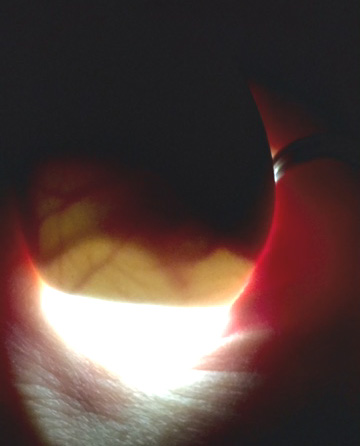 |
This Ancona
duck egg has been incubating for 21 days. The photo was taken by Liz in
Franklin, North Carolina.
"Eggs have really filled up with ducklings! One
week to go till we meet our babies...will send you more pics on their birthday."
-Liz, Franklin, North Carolina
|
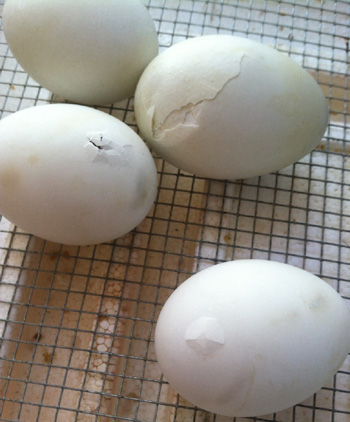
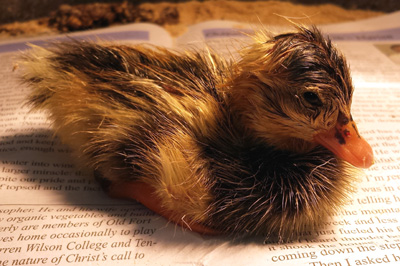 |
4 Ancona
duck eggs starting to hatch.
Next is a just-hatched duckling still wet from
the egg.
Both photos are from John.
"The box arrived in excellent shape. I let it sit overnight so the eggs would settle. The 15 duck eggs are in the incubator, and the science teacher will help me candle them on day 8." -John, 6th grade teacher, Spruce Pine, North Carolina
Then 28 days later:
"The first duck is out! All my students are so
excited. He chirps a lot! We expect more birthdays today." -John, 6th
grade teacher
|
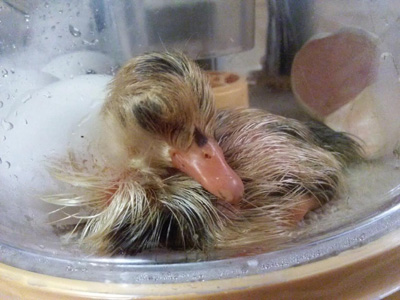 |
This photo is from Betsy in Indian Trail, North Carolina.
"The first duckling hatched today. Beautiful and loud.
Three more eggs are notched."
Update: "I have seven healthy ducklings that have tripled in size in less than 2 weeks." -Jay, Raphine, Virginia
|
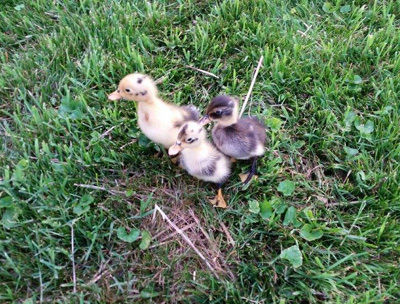 |
It's a
big world when you are a small duckling. This photo is from Ray in Louisburg,
North Carolina.
"We candled the dozen eggs last night, and 11 of 12 are fertile and doing great. We are very happy." -Ray, Louisburg, NC
|
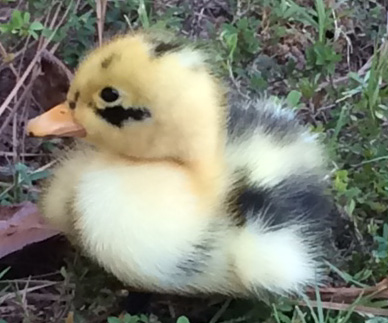 |
A cute
duckling enjoying life on the lawn.
|
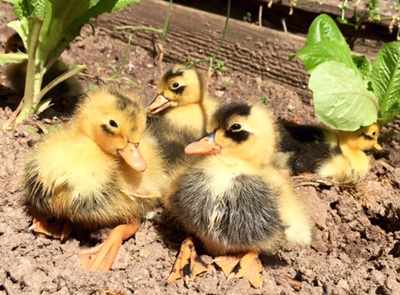 |
This photo
is from Liz. The below 2 photos are also from Liz. The photo with the mountains
is 6-day-old ducklings.
"All 6 ducklings are doing great and already helping in the garden at only 2 days old." -Liz, Franklin, North Carolina
|
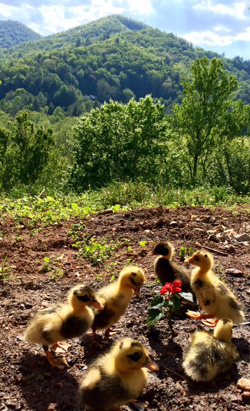 |
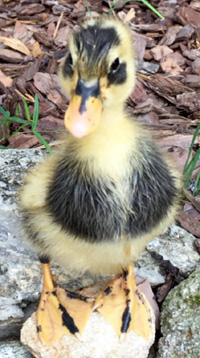 |
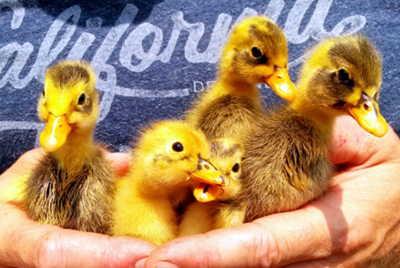
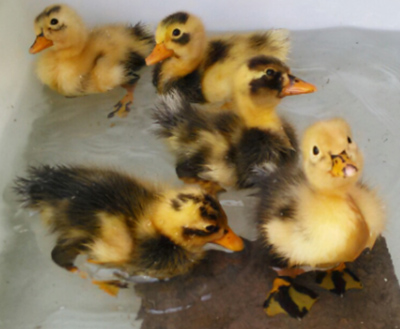 |
These 2 photos are from Betsy in Indian Trail, North Carolina.
"We had 5/6 successfully hatch!!" -Betsy
|
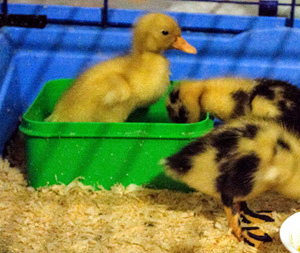 |
Ancona
duckling in his green "pond" with friends. This photo is from
Mihai in Romania.
|
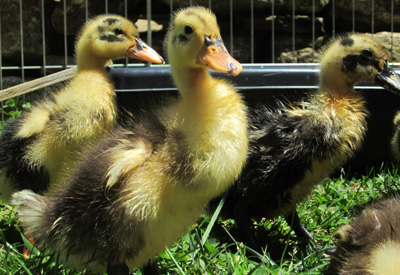 |
Sweet Ancona
ducklings. Photo by Bryan in Asheville, North Carolina.
"We have raised 3 absolutely beautiful Ancona ducks
from egg hatchlings that we purchased from you a few months back. They are
vibrant, healthy, and lots of fun to watch." -Steven, Cullowhee, North
Carolina
|
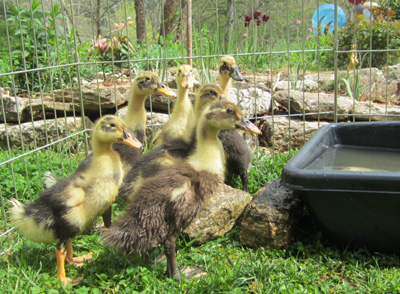 |
A group
of older Ancona ducklings by their kiddie pool / "pond". Photo
by Bryan.
"Your Ancona duck babies from last year developed into a chattery, healthy flock. We LOVE them!" -Anja, Bend, Oregon
|
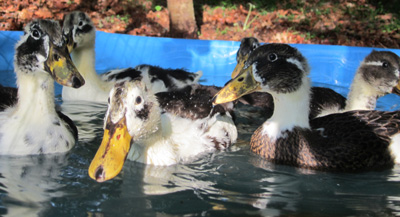 |
The same
ducklings as the above 2 photos that are a little bit older. Photo by Bryan.
|
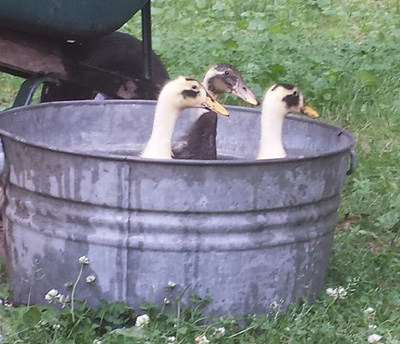 |
Three Ancona
ducklings enjoying a swim in a metal tub. Photo from Jill.
"I'm pretty much run by ducklings at the moment! They are still such little delights. Some are really starting to find their quacks, and enjoying being in the yard. All 6 are doing well, looks like 5 black and white and 1 tricolor. Such sweet babies, 3 weeks old yesterday!" -Jill, Chapel Hill, North Carolina
|
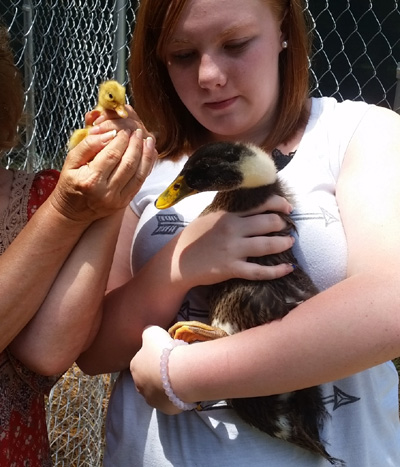 |
A 3-day-old
duckling with a 33-day-old duckling. Ducks grow a lot in only 1 month! Photo
by Ray in Louisburg, North Carolina.
"We are very happy and pleased to be growing our
duck family, and expanding yours in to North East NC. We have 10 healthy
ducks with three at 33 days old and the other seven at 1-3 days old."
-Ray, Louisburg, North Carolina
|
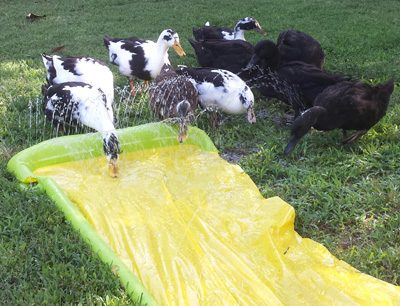 |
This photo
is from Jill, Chapel Hill, North Carolina. These ducks were incubated together.
They are 11 weeks old. The all-black ducks are Cayuga.
"They are pretty spoiled. I figured this was a
new one for you - ducks on the slip and slide! They loved the spray part
and kept biting at it, getting braver and braver. Also a testament to their
friendliness, as my 3 kids were feet away splashing in a kiddie pool."
-Jill
|
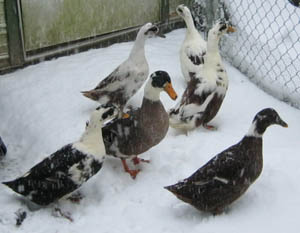 |
Ancona
ducks like snow. They do better in cold weather than chickens do. They especially
like it when it rains. |
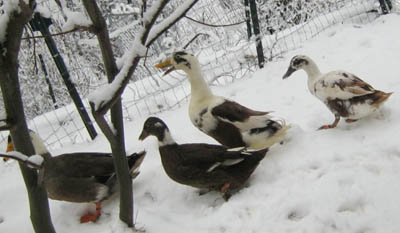 |
More fun
in the snow. You can see the curled tail of the chocolate and white male.
Also a curled tail in the next photo. |
 |
"I think
part of what makes Anconas so much fun is that you can tell all the individuals,
at least you can if you keep all the colors and patterns. I think separating
them by color is a step in the wrong direction. Also, part of their behavior
may depend upon the fact that they can so easily tell each other apart.
I noticed that Anconas treat single-color breed ducks as generic ducks,
not as individuals. I also suspect the vigor of the breed is because they
are very heterozygous for all the chromosomes involving color genes. Pure
color groups is just a bad idea, I think. It is failing to appreciate what
is unique about this breed." -Carol Deppe, Ancona Duck Breeder, 2010 |
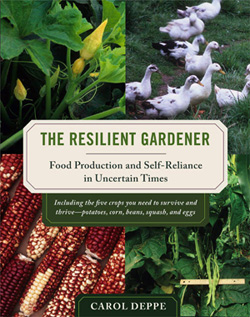 |
The book "The Resilient Gardener: Food Production
and Self-Reliance in Uncertain Times" by Carol Deppe has a chapter on Ancona ducks.
See quote from it below.
|
From
"The Resiliant Gardener", chapter "The Laying Flock":
"For production
of big eggs as well as dual-purpose production of eggs and meat, I recommend Anconas.
Anconas lay about 210-280 eggs per year, mostly jumbo and super-jumbo size...
Ancona are calmer, more sensible, and easier to work with than extreme-egg breeds
(producers of 300 or more eggs per year)."
"They are quite mellow and flexible
about their dominance hierarchy. They have one, but nobody seems to take it very
seriously. Nobody excludes anybody from anything because of it."
"They
rarely have any leg or foot problems. Anconas come in various colors with pinto-style
white markings that allow you to identify each individual, even at a distance.
The colors are black, blue, chocolate, lavender, and silver."
"Anconas
are the best foragers of all the medium-weight duck breeds... Anconas have female
flock leaders. Because of their female leaders, Ancona flocks forage better than
Campbell or Harlequin flocks. Anconas have more complex flock behavior than other
duck breeds, with a more sophisticated ability to communicate."
"Flocks
are led by female leaders chosen by the consent of the led. The behavior of Anconas lends itself ideally to egg production under free-range conditions."
"Anconas are very alert and sensible about predators
and make better watchdogs than the geese I used to have. They are especially smart
about hawks... I can usually tell what the flock is doing just by the sound."
"Ancona
ladies are usually capable of hatching out a clutch of eggs and make good mothers."
Buying
Ancona eggs.
| |
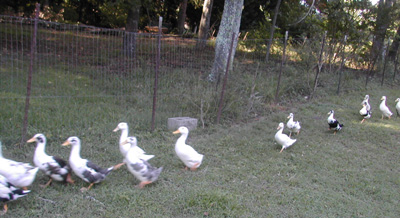 |
Get all your ducks in a row! This photo of Ancona ducks is from Kat in Gainesville, Georgia. |
| |
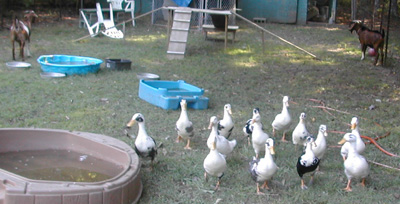 |
This photo is also from Kat. There are goats in the background. They get along great with ducks. |
| |
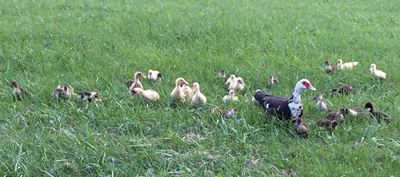 |
This photo
is from Jason in New Martinsville, West Virginia. The adult is a Muscovy
duck. There are Muscovy and Ancona ducklings with her. All the ducklings
get along well with each other. |
|
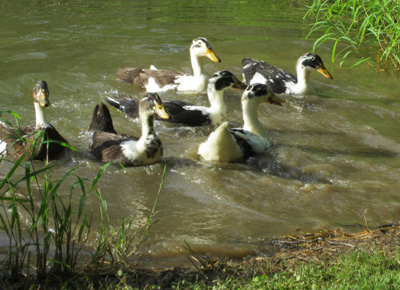 |
A flock
of Ancona ducks in a pond enjoying the good life. This photo is from Bryan
in Asheville, North Carolina. |
|
 Ancona ducks make good pets because they do not migrate, do not even fly,
and like staying close to home. They are calm, and if handled when young
are friendly and affectionate.
Ancona ducks make good pets because they do not migrate, do not even fly,
and like staying close to home. They are calm, and if handled when young
are friendly and affectionate.  The hens are excellent layers usually laying 210-280 cream (off-white),
green or blue eggs each year. Most of my Ancona ducks lay cream eggs. A
few lay green eggs. Their eggs are larger than chicken eggs.
The hens are excellent layers usually laying 210-280 cream (off-white),
green or blue eggs each year. Most of my Ancona ducks lay cream eggs. A
few lay green eggs. Their eggs are larger than chicken eggs. Ancona
ducks grow fairly quickly producing high quality meat that is more flavorful
and less fatty than Pekin ducks (Long Island duck). We had one male duck
for Christmas dinner and were very happy with it. They are a great dual
purpose (meat and egg) bird.
Ancona
ducks grow fairly quickly producing high quality meat that is more flavorful
and less fatty than Pekin ducks (Long Island duck). We had one male duck
for Christmas dinner and were very happy with it. They are a great dual
purpose (meat and egg) bird.  They
are descended from Indian Runner ducks and Belgian Huttegem ducks. This is the
same foundation stock as Magpie ducks and Dutch Hookbills. They were developed
in England during the early 1900s but were not shipped to the United States
until 1984.
They
are descended from Indian Runner ducks and Belgian Huttegem ducks. This is the
same foundation stock as Magpie ducks and Dutch Hookbills. They were developed
in England during the early 1900s but were not shipped to the United States
until 1984. Some
are all white though this is not the breed standard. Ducks with an all white
bib are not the breed standard either. The Ancona is not yet recognized by the
American Poultry Association. Unique patterns are preferred. Birds with high
egg production are also preferred.
Some
are all white though this is not the breed standard. Ducks with an all white
bib are not the breed standard either. The Ancona is not yet recognized by the
American Poultry Association. Unique patterns are preferred. Birds with high
egg production are also preferred. Female ducks start to lay eggs from 17 to 34 weeks (4 1/4 to 8 1/2 months) old. They lay for 5 to 8 years with the most productivity in the first 3 years. Eggs get bigger as the birds get older. They usually lay their eggs between 4 and 7 am. The eggs incubate
for 28 days.
Female ducks start to lay eggs from 17 to 34 weeks (4 1/4 to 8 1/2 months) old. They lay for 5 to 8 years with the most productivity in the first 3 years. Eggs get bigger as the birds get older. They usually lay their eggs between 4 and 7 am. The eggs incubate
for 28 days. Ancona
Ducks are considered rare (critical status) by the
Ancona
Ducks are considered rare (critical status) by the 

















